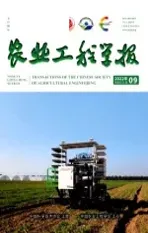振动深松试验台作业参数减阻减振优化
2017-01-09孙亚朋董向前宋建农刘彩玲王继承
孙亚朋,董向前,宋建农,刘彩玲,王继承,张 超
振动深松试验台作业参数减阻减振优化
孙亚朋,董向前,宋建农※,刘彩玲,王继承,张 超
(农业部土壤-机器-植物系统技术重点实验室,中国农业大学,北京 100083)
振动深松具有降低耕阻的作业优势,但振动对驾驶员造成的负面影响是制约其推广使用的主要因素之一。该文采用二次回归通用旋转设计,考察深松铲振频、振幅、前进速度3个工作参数与耕阻、振动2个试验指标的关系,利用Design-Expert响应面分析法,得到2个指标的回归模型,并进行优化分析。综合分析得到一组减阻减振的优化解:振幅21 mm、振频4.2 Hz、前进速度3.4 km/h,在该组工作参数下,与非振动深松相比,振动深松的耕阻最大值变化较小,耕阻最小值、平均值分别减小46.2%、16.6%。
农业机械;优化;振动;深松;响应面法
0 引 言
深松是利用深松部件在不翻转土壤的条件下,疏松土壤、打破犁底层、加深耕作层。深松可以保持地表覆盖物,减少表土翻动,对于北方寒冷的旱区,深松可以提高地温,促进种子发芽,有利于作物的增产[1-5]。深松的作业深度超过犁底层或土壤自然形成的黏盘层分布深度[6],使耕层由翻地的20 cm左右加深到30~35 cm。但深松作业牵引阻力大,需要配备大马力拖拉机,限制其推广使用。
与非振动深松相比,振动深松充分利用拖拉机动力输出轴的功率,有效降低牵引阻力,并提高松土效果,在保证松土质量的同时降低对拖拉机马力的要求[7-17]。
国内外在深松减阻方面开展了大量研究。Shahgoli等[18-19]以单立柱凿式深松铲为试验对象,分别对振频、振动角进行单因素试验,同时考虑耕阻和总功耗,得到最优作业频率为3.3 Hz,最优振动角为1.5°。
在多因素试验方面,李霞选取前进速度、振频、振动角度3个因素,对单立柱振动深松铲进行正交试验,试验得出当前进速度2 km/h,振动频率10 Hz,振动角度12°时,牵引阻力和总功率最小。与不振动深松相比,振动深松机牵引阻力平均降幅为9.09%[20]。
王俊发等[21]选取振频、前进速度、振幅3个因素进行二次正交旋转试验,得到优化参数为振幅20~25 mm,振频2~3 Hz,铲机速比1.7~2.2,牵引阻力降低30%。并且得出振动深松会增加总功耗,振频越高,功耗越大。
目前对振动深松的研究,主要以减少耕作阻力为优化目标。振动深松机的振动传递到拖拉机,对拖拉机及机手造成不良影响,是振动深松推广面临的难题之一。农业机械注重提供安全、舒适的操作环境,提高振动深松减阻效果的同时需要降低振动对拖拉机的影响。
目前的研究主要以单立柱深松铲为研究对象,与单立柱深松铲相比,框架式深松铲可以实现全方位深松,进一步提高松土效果[7-12,22]。
在相关研究基础上,本文以框架式深松铲为研究对象,使用二次回归通用旋转设计,考察深松铲振频、振幅、前进速度3个工作参数与前进、竖直2个方向力的关系,利用Design-Expert响应面分析法,得到2个指标的回归模型,并进行优化,将优化结果与非振动深松对比评价。
1 试验设备与试验方法
1.1 室内振动深松试验台
为进行振动深松试验研究,中国农业大学土壤-机器-植物系统技术实验室设计了室内振动深松试验台(图1)。土壤-机器-植物系统技术实验室主要由土槽、台车和控制系统组成。土槽两侧为台车轨道,台车模拟拖拉机工作,可挂接农机具,并配备动力输出轴(power take off,PTO)。台车上配备六分力测力机构和土壤含水率、紧实度测量仪。通过控制系统设置前进速度、动力输出轴转速、耕深,输出三向力、土壤参数报表[23]。
试验装置由机架、变速箱、偏心机构、连杆、拉杆、框架式深松铲组成。试验台机架通过螺栓与台车六分力测力机构连接,台车动力输出轴的动力经万象联轴器传递至变速箱输入端,经变速箱减速、变向,动力由变速箱输出端传递至偏心机构,偏心机构由2个偏心圆盘组成,偏心机构转动产生的偏心激振力,经连杆带动拉杆及深松铲绕铰接点上下振动(图2)。
框架式深松铲以全方位深松机V型深松部件为原型,为降低激振难度,采用小幅宽铲型(图3)。深松铲底刀起土角为35°,侧刀切土角为2°,侧刀后倾角为23°,侧刀在横垂面内的倾角为77°,底刀和左、右侧刀均采用下磨刃。
1.2 土壤制备
为了模拟田间土壤条件,增加试验结果的可比性,室内试验要求土槽土壤含水率、紧实度基本一致,土壤表面平整,为了达到此要求,试验前对土槽土壤进行如下整理:
1)在试验前一天,使用台车底部洒水装置洒水润土;
2)用振动深松机均匀深松土槽土壤,设置松土深度为300 mm,实际松土深度为330 mm,保证土壤制备范围≥试验松土范围;
3)用旋耕机旋碎大土块;
4)用冲击压实装置[24]夯实土壤,6遍。
使用台车配备的HYD-ZS在线水分测量仪、SZ-3土壤硬度计,测量得到试验土壤条件(表1)。

表1 试验土壤条件
2 试验设计
2.1 试验因素水平与指标
在对框架式深松铲的振频单因素研究中,以耕阻为优化指标,在低速小振幅条件下(1 km/h,12.7 mm)得到最佳振频4.4 Hz[25];在预试验中,同时增大振幅、振频,则振动加剧,台车稳定性降低,影响试验正常进行。综合考虑耕阻和振动2个指标,得到一组水平范围:振幅水平范围15~43 mm,振频水平范围1~5 Hz,前进速度水平范围1~4 km/h。根据深松要求,设置耕深为300 mm。
以前进方向力的平均值为耕阻指标1(mean of resisting force)。预试验中,竖直方向力的变化最大,为振动的主要来源。以竖直方向力的波幅振动指标2(range of vibratory force),为排除两端极端值的影响,该波幅以四分位距表示。
2.2 二次回归通用旋转设计
在Design-Expert软件中,选用响应面设计中的中心组合设计,设定因素数为3,中心点数为6,星号点值在旋转条件下为1.682,设置编码水平的±的实际值为试验因素水平范围的边界值。

式中Coded为编码值、、,Actual为实际值、、,Hi、Low为因素上、下水平±实际值。
计算得到因素水平编码(表2)。设置响应为耕阻1和振动指标2,得到编码值表示的试验计划表(表3),总试验次数=20。中心点试验顺序的均匀分配可以探测试验数据与时间的关联,因此将试验号随机排序得到试验顺序。试验现场如图4所示。
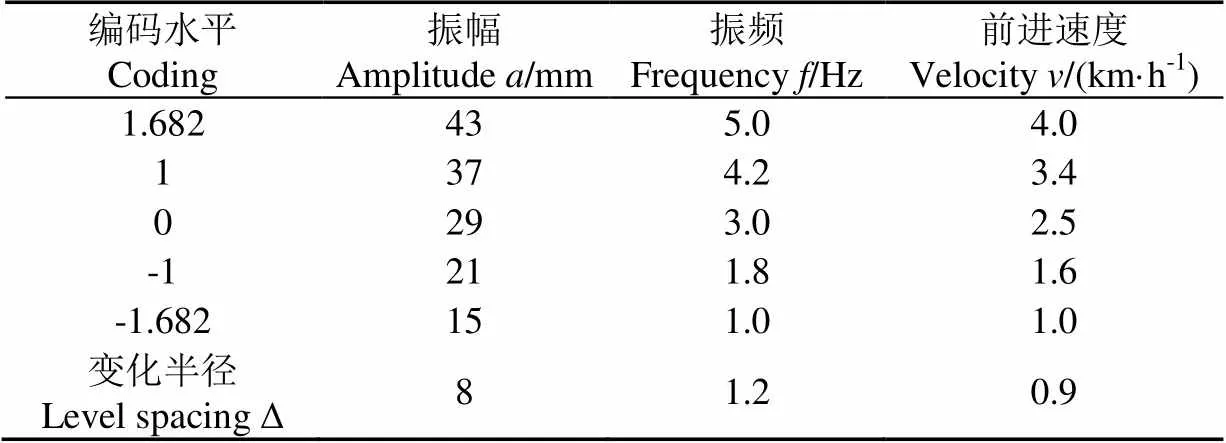
表2 因素水平编码表
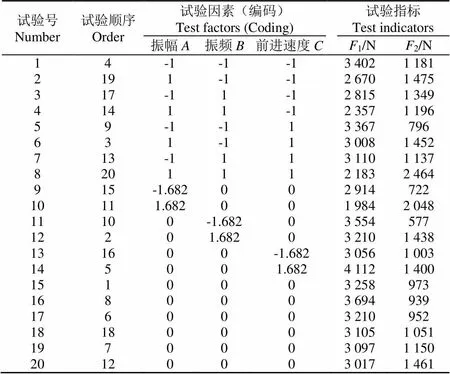
表3 试验计划与试验结果
注:1为前进方向力的平均值,即耕阻指标;2为竖直方向力的波幅,即振动指标。
Note:1represents mean of resisting force;2represents amplitude of vibratory force.
3 试验结果分析
3.1 回归分析
试验结果列入表3中试验结果栏。回归模型选用二次模型,回归方法选用逐步回归法,引入和剔除变量的检验水准设定为0.10,对1进行二次回归建模(表4)。得到编码方程

(3)
实际方程

(5)
2的方差分析中,不显著,但是回归模型中包含显著的交互作用项、,排除将使模型不满足层级结构,因此将显著交互作用项中的所有子项加入模型。
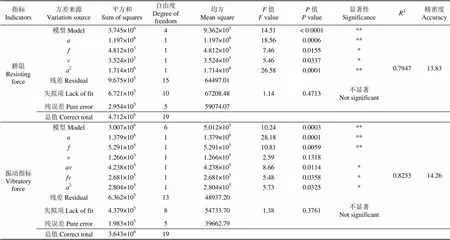
表4 耕阻F1与振动指标F2的方差分析表
注:**表示极显著(<0.01);*表示显著(0.01<<0.05)。
Note: ** means highly significant (<0.01); * means significant (0.01<<0.05).
3.2 影响力主次分析
3.2.1 直观分析
在编码方程中,各因素水平编码上、下水平分别为+1.682和-1.682,各自变量经过编码处理,单位、区间一致,通过比较编码方程中各因素系数的绝对值,可以考察各因素在相同编码区间内对指标的影响大小。
对于耕阻1,式(2)中一次项的主次顺序为>>,二次项的主次顺序为>>。因为二次项在编码区间内单调性不唯一,所以不能将一、二次项主次顺序简单叠加。
由耕阻1的方差分析可知,各因素间不存在交互作用,在其他因素取不同水平条件下,振幅变化规律一致。编码方程(2)中,把其他因素固定在0水平,得到振幅的变化对耕阻1的扰动曲线(图5),该曲线方程为

该曲线在=−0.4的曲率为0,即振幅在该编码水平附近对指标扰动较小。
同理,可得到振频、前进速度的变化对耕阻1的扰动曲线。曲线斜率越高,表明该因素的变化对指标的扰动越大,而相对平缓的曲线则说明因素对指标的扰动较小。由图5可知,振幅小于“−0.4”水平时,扰动较小,响应与振幅呈正相关;大于“−0.4”水平时,扰动较大,耕阻与振幅呈负相关。响应与振频呈负相关,与前进速度呈正相关,斜率分别为−188、161。虽然振幅在编码水平为−0.4附近对指标扰动较小,但在整个编码范围内为扰动最大的因素。因此可以得到影响力排序(正相关→负相关)>(负相关)>(正相关)。
由振动指标2方差分析可知,振幅与前进速度,振频与前进速度间存在交互作用,在前进速度取不同水平条件下,振幅的变化曲线不平行,变化规律改变。因此不能得出整个试验范围内的主次关系,只能得到其他因素在固定水平下的主次关系,图5为其他因素在“0”水平下的扰动曲线,可以得到影响力排序为(正相关)>(正相关)>(正相关)。
3.2.2 通径分析
对于存在交互作用项的2,采用通径分析考察各因素影响力大小[26-29]。在通径分析中,各因素与2的相关系数可分解为该因素对2的直接作用和间接作用,即

对于2的直接作用与间接作用分析见表5。由检验结果可知,的回归系数不显著,其他项均显著。但是考虑到模型中交互作用项的层级结构,保留子项进行分析。

表5 振动指标F2通径分析
1)振幅增大,一次项直接使2减小(−2.629),并且通过二次项2,使2增大(2.02)。另外,增大,交互作用项增大,间接使2增大(1.22),综合作用为增强振动(0.615)。
2)振频增大,直接作用系数不显著,但是通过交互作用项(0.98)的间接作用系数显著,使2增大。如果不考虑直接作用,显然会高估对2的作用,因此考虑对2的直接作用(−0.6),使2减小。综合作用为增强振动(0.381)。
3)前进速度增大,直接使振动减小(−2.306),并通过交互作用项(1.61)、(0.88)间接使振动增加。综合作用为增强振动(0.186)。
综合直接与间接作用将各因素影响力排序为(0.615)>(0.381)>(0.186),均为正相关。对于减小2,减小振幅比减小振频更有效。
3.3 多目标优化分析与验证
满意度函数法是常用的多目标优化方法[30-31]。满意度的计算公式如下:
单目标满意度
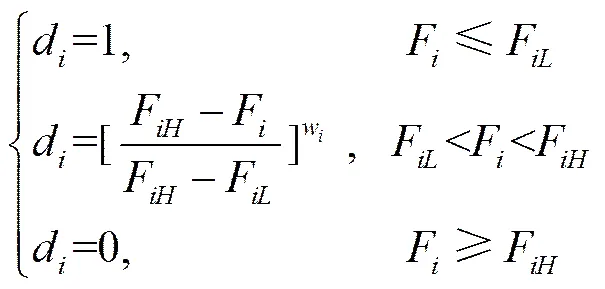
式中d为单目标满意度;w为每个目标的权值(weight),本文中1、2的重要性相同,因此设置1=2=0.5;F为目标函数试验值,N;F为各目标函数在自变量定义域内得到的最大值,N;F为最小值,N;回归模型(3)、(5)在工作参数[−1,1]编码水平范围内得到1H=4 112 N,1L=1 984 N;2H=2 464 N,2L=577 N。
多目标满意度

式中为多目标满意度;r为各个目标相对于其他目标的重要值(importance),设置1=2=0.5。
联立式(8)、(9),得到多目标满意度响应曲面(图6)。低速前进时,在大振幅、大振频(37 mm,4.2 Hz)条件下,满意度最大;随着前进速度的提高,在小振幅、大振频(21 mm,4.2 Hz)条件下,满意度最大。为了实现高速高效作业,选择高速前进、小振幅、大振频(3.4 km/h,21 mm,4.2 Hz)为多目标优化结果,并得到区间估计值(表6)。优化参数下的试验值在区间估计范围之内,表明模型具有较好的准确性。

表6 预测与实际试验指标对比
3.4 振动与非振动深松作业情况对比
为衡量振动深松减阻效果,将其与非振动深松作对比分析。在土壤条件、耕深和前进速度相同的条件下,分别进行振动、非振动2种深松试验。与非振动深松相比,振动深松耕阻最小值减小46.2%;最大值减小1.5%,变化较小;平均值减小16.6%(表7);振动深松后大土块较少(图7),松土效果提高。

表7 振动与非振动深松作业对比
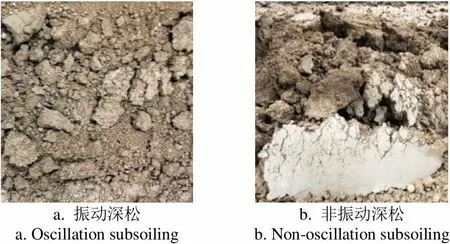
a. 振动深松 a. Oscillation subsoilingb. 非振动深松 b. Non-oscillation subsoiling
图7 深松效果对比
Fig.7 Comparison of operation effect between oscillation and non-oscillation subsoiling
4 结 论
本文针对框架式振动深松铲振频、振幅、前进速度3个工作参数与耕阻、振动2个试验指标的关系进行了分析讨论,得出以下结论:
1)在冲击压实后的土壤条件下,振幅、振频、前进速度与耕阻1、振动指标2之间符合三元二次回归模型。
2)在试验条件下,振幅、振频、前进速度对1、2均具有显著作用,特别是振幅对1有极显著作用,振幅、振频对2有极显著作用。对于耕阻1,各因素无交互作用,作用大小依次为:振幅(负相关)>振频(负相关)>前进速度(正相关);对于振动指标2,振幅与前进速度、振频与前进速度有交互作用,各因素作用大小依次为:振幅(正相关)>振频(正相关)>前进速度(正相关)。
3)在试验条件下,得到耕阻、振动均较小的多目标优化组合方案为:振幅21 mm、振频4.2 Hz、前进速度3.4 km/h。在该组合条件下,与非振动深松相比,振动深松耕阻平均值减小16.6%;最小值减小46.2%;最大值变化较小;振动深松后大土块较少,松土效果提高,实现了在提高振动深松减阻效果的同时降低振动的目的。
[1] 郑侃,何进,李洪文,等. 中国北方地区深松对小麦玉米产量影响的Meta分析[J]. 农业工程学报,2015,31(22):7-15.
Zheng Kan, He Jin, Li Hongwen, et al. Meta-analysis on maize and wheat yield under subsoiling in Northern China[J]. Transactions of the Chinese Society of Agricultural Engineering (Transactions of the CSAE), 2015, 31(22): 7-15. (in Chinese with English abstract)
[2] 张瑞富,杨恒山,高聚林,等. 深松对春玉米根系形态特征和生理特性的影响[J]. 农业工程学报,2015,31(5):78-84.
Zhang Ruifu, Yang Hengshan, Gao Julin, et al. Effect of subsoiling on root morphological and physiological characteristics of spring maize[J]. Transactions of the Chinese Society of Agricultural Engineering (Transactions of the CSAE), 2015, 31(5): 78-84. (in Chinese with English abstract)
[3] 何进,李洪文,高焕文. 中国北方保护性耕作条件下深松效应与经济效益研究[J]. 农业工程学报,2006,22(10):62-67.
He Jin, Li Hongwen, Gao Huanwen. Subsoiling effect and economic benefit under conservation tillage mode in Northern China[J]. Transactions of the Chinese Society of Agricultural Engineering (Transactions of the CSAE), 2006, 22(10): 62-67. (in Chinese with English abstract)
[4] 郭志军,佟金,周志立,等. 深松技术研究现状与展望[J]. 农业工程学报,2001,17(6):169-174.
Guo Zhijun, Tong Jin, Zhou Zhili, et al. Review of subsoiling techniques and their applications[J]. Transactions of the Chinese Society of Agricultural Engineering (Transactions of the CSAE), 2001, 17(6): 169-174. (in Chinese with English abstract)
[5] 张祥彩,李洪文,王庆杰,等. 我国北方地区机械化深松技术的研究现状[J]. 农机化研究,2015(8):261-264.
Zhang Xiangcai, Li Hongwen, Wang Qingjie, et al. Research on mechanized subsoiling technology[J]. Journal of Agricultural Mechanization Research, 2015(8): 261-264. (in Chinese with English abstract)
[6] 王志穷,王维新,李霞,等. 保护性耕作条件下深松技术的国内外发展现状[J]. 农机化研究,2016(6):253-258.
Wang Zhiqiong, Wang Weixin, Li Xia, et al. Development status of subsoiling at home and abroad under conservation tillage[J]. Journal of Agricultural Mechanization Research, 2016(6): 253-258. (in Chinese with English abstract)
[7] 徐宗保,董欣,李紫辉,等. 振动式深松中耕作业机的研制与试验研究[J]. 农机化研究,2010(1):182-184.
Xu Zongbao, Dong Xin, Li Zihui, et al. Development and experimental study of the machine of vibrating deeploose and Intertillage[J]. Journal of Agricultural Mechanization Research, 2010(1): 182-184. (in Chinese with English abstract)
[8] 汤明军,王维新,李霞,等. 振动深松机的研究进展与展望[J]. 农机化研究,2016(4):258-263.
Tang Mingjun, Wang Weixin, Li Xia, et al. Research progress and prospect of vibrating subsoiler[J]. Journal of Agricultural Mechanization Research, 2016(4): 258-263. (in Chinese with English abstract)
[9] 付俊峰,张东兴,李霞,等. 振动深松机的改进设计与试验研究[J]. 中国农业大学学报,2011,16(6):158-162.
Fu Junfeng, Zhang Dongxing, Li Xia, et al. An improved design and field experiments for a vibration subsoiler[J]. Journal of China Agricultural University, 2011, 16(6): 158-162. (in Chinese with English abstract)
[10] 李霞,付俊峰,张东兴,等. 基于振动减阻原理的深松机牵引阻力试验[J]. 农业工程学报,2012,28(1):32-36.
Li Xia, Fu Junfeng, Zhang Dongxing, et al. Experiment analysis on traction resistance of vibration subsoiler[J]. Transactions of the Chinese Society of Agricultural Engineering (Transactions of the CSAE), 2012, 28(1): 32-36. (in Chinese with English abstract)
[11] Sakai K, Hata S I, Takai M, et al. Design parameters of 4-shank vibrating subsoiler[J]. Transactions of The ASAE, 1993, 36(1): 23-26.
[12] Niyamapa T, Salokhe V M. Force and pressure distribution under vibratory tillage tool[J]. Journal of Terramechanics, 2000, 37(3): 139-150.
[13] 邱立春,李宝筏. 自激振动深松机减阻试验研究[J]. 农业工程学报,2000,16(6):72-76.
Qiu Lichun, Li Baofa. Experimental study on the self-excited vibration subsoiler for reducing draft force[J]. Transactions of the Chinese Society of Agricultural Engineering (Transactions of the CSAE), 2000, 16(6): 72-76. (in Chinese with English abstract)
[14] 李艳龙,刘宝,崔涛,等. 1SZ-460型杠杆式深松机设计与试验[J]. 农业机械学报,2009,40(S1):37-40.
Yanlong Li, Bao Liu, Tao Cui, et al. Design and field experiment on 1SZ-460 lever-type subsoiler[J]. Transactions of The Chinese Society of Agricultural Machinery, 2009, 40(S1): 37-40. (in Chinese with English abstract)
[15] 王俊发,刘孝民,陈玉芳,等. 振动深松机理的探讨[J]. 佳木斯大学学报:自然科学版,2000,18(4):335-338.
Wang Junfa, Liu Xiaomin, Chen Yufang, et al. Study on vibrating tillage mechanism[J]. Journal of Jiamusi University: Natural Science Edition, 2000, 18(4): 335-338. (in Chinese with English abstract)
[16] 蒋建东,高洁,赵颖娣,等. 基于ALE有限元仿真的土壤切削振动减阻[J]. 农业工程学报,2012(增刊1):33-38.
Jiandong Jiang, Jie Gao, Yingdi Zhao, et al. Numerical simulation on resistance reduction of soil vibratory tillage using ALE equation[J]. Transactions of the Chinese Society of Agricultural Engineering (Transactions of the CSAE), 2012(Supp.1): 33-38. (in Chinese with English abstract)
[17] 辛丽丽,李传琦,梁继辉,等. 考虑分段土壤作用力的振动减阻分析[J]. 农业机械学报,2014(2):136-140.
Xin Lili, Li Chuanqi, Liang Jihui, et al. Vibrating drag reduction considering acting force of piecewise soil[J]. Transactions of The Chinese Society of Agricultural Machinery, 2014(2): 136-140. (in Chinese with English abstract)
[18] Shahgoli Gholamhossein, Fielke John, Desbiolles Jacky, et al. Optimising oscillation frequency in oscillatory tillage[J]. Soi & Tillage Research, 2010, 106(2): 202-210.
[19] Shahgoli Gholarnhossein, Saunders Chris, Desbiolles Jacky, et al. The effect of oscillation angle on the performance of oscillatory tillage[J]. Soi & Tillage Research, 2009, 104(1): 97-105.
[20] 李霞,张东兴,王维新,等. 受迫振动深松机性能参数优化与试验[J]. 农业工程学报,2015,31(21):17-24.
Li Xia, Zhang Dongxing, Wang Weixin, et al. Performance parameter optimization and experiment of forced-vibration subsoiler[J]. Transactions of the Chinese Society of Agricultural Engineering (Transactions of the CSAE), 2015, 31(21): 17-24. (in Chinese with English abstract)
[21] 王俊发,魏天路,刘孝民. 振动深松的试验研究[J]. 农业机械学报,2001,32(3):33-35.
Wang Junfa, Wei Tianlu, Liu Xiaomin. Experimental study on vibrating subsoiling[J]. Transactions of The Chinese Society of Agricultural Machinery, 2001, 32(3): 33-35. (in Chinese with English abstract)
[22] 谷谒白,刘向阳. 1SQ-250型全方位深松机的研制与试验[J]. 北京农业工程大学学报,1994,14(4):42-48.
Gu Yebai, Liu Xiangyang. Development and experiment on 1SQ-250 model of bulk subsoiler[J]. Journal of Beijing Agricultural Engineering University, 1994, 14(4): 42-48. (in Chinese with English abstract)
[23] 吴俭敏,朱立成,米义,等. 新型土槽试验台的研制[J]. 农机化研究,2011(3):92-95.
Wu Jianmin, Zhu Licheng, Mi Yi, et al. The development of the new soil bin test-bed[J]. Journal of Agricultural Mechanization Research, 2011(3): 92-95. (in Chinese with English abstract)
[24] 王继承,董向前,孙亚朋,等. 一种可调频振动压实装置[P]. CN204803877U.
Wang Jicheng, Dong Xiangqian, Sun Yapeng, et al. Frequency modulation vibrating compacting device[P]. CN204803877U. (in Chinese with English abstract)
[25] 董向前,宋建农,王继承,等. 草地振动松土机运动特性分析与振动频率优化[J]. 农业工程学报,2012,28(12):44-49.
Dong Xiangqian, Song Jiannong, Wang Jicheng, et al. Vibration frequency optimization and movement characteristics analysis of vibration shovel for meadow[J]. Transactions of the Chinese Society of Agricultural Engineering (Transactions of the CSAE), 2012, 28(12): 44-49. (in Chinese with English abstract)
[26] 杜家菊,陈志伟. 使用SPSS线性回归实现通径分析的方法[J]. 生物学通报,2010,45(2):4-6.
Du Jiaju, Chen Zhiwei. Method of path analysis with SPSS linear regression[J]. Bulletin of Biology, 2010, 45(2): 4-6. (in Chinese with English abstract)
[27] 徐向宏,何明珠. 试验设计与Design-Expert、SPSS应用[M]. 北京:科学出版社,2010:79-84.
[28] 张琪,丛鹏,彭励. 通径分析在Excel和SPSS中的实现[J]. 农业网络信息,2007(3):109-110.
[29] 任红松,吕新,曹连莆,等. 通径分析的SAS实现方法[J]. 计算机与农业·综合版,2003(4):17-19.
Ren Hongsong, Lu Xi, Cao Lianpu, et al. The implemented method of SAS in path analysis[J]. Computer and Agriculture, 2003(4): 17-19. (in Chinese with English abstract)
[30] 张昆,高振,李霜,等. 基于Desirability函数法对米根霉发酵制备富马酸的多目标优化[J]. 中国生物工程杂志,2008,28(4):59-64.
Zhang Kun, Gao Zhen, Li Shuang, et al. Multiple target optimization on the fumaric Acid production by rhizopusoryzae based on desirability function[J]. China Biotechnology, 2008, 28(4): 59-64. (in Chinese with English abstract)
[31] 刘爱琴,罗超杰,周迪,等. 满意度函数法对维生素A微胶囊的多目标优化[J]. 食品研究与开发,2014,35(8):46-50.
Liu Aiqin, Luo Chaojie, Zhou Di, et al. Multiple target optimization on vitamin A microencapsulation by desirability function approach[J]. Food Research And Development, 2014, 35(8): 46-50. (in Chinese with English abstract)
Parameter optimization of vibration subsoiler test bed for reducing resistance and vibration
Sun Yapeng, Dong Xiangqian, Song Jiannong※, Liu Cailing, Wang Jicheng, Zhang Chao
(,100083,)
The oscillatory tillage was proved to be more efficient than rigid tillage. Oscillation could reduce the drag resistance during tillage. But the oscillation had a bed effect on the tractor. Oscillation damaged the tractor and was harmful to tractor driver. The goals were to reduce the drag residence and the effect on the tractor. These two goals couldn’t be optimum at the same time. But it had a relative optimum combination. The Six-component test system on the experiment trolley could measure the forces in the directions of heading(), vertical () and crosswise (). Define the mean value of-direction force as the mean of resisting force1, the interquartile range of-direction force as the range of vibratory force2. The working parameter of oscillatory tillage that to be considered were amplitude e(), frequency () and velocity () in the experiments. Using quadratic general revolving combination design with 3 factors, the regression models between1,2and amplitude, frequency, velocity were founded. There were two three-factor quadratic regression models. The influence order could be found in the perturbation graph for non-interaction parameters, but couldn’t be found for interactive parameters, because the trend of perturbation curve changed when the interactive parameters was changed. The path analysis method could find both direct and indirect influences of interactive parameters. Using the interaction analysis method in the Design-Expert and the path analysis method in the SPSS, the influence order of three factors was determined,>>, to both1and2. There were no optimal solutions for this multi-objective optimization problem, but there were relative optimal solutions for it through the method of desirability function method. The higher the desirability value, the better the solution. From the 3D response surface of desirability at different velocities, in order to achieve high speed work, the relative optimal solution of both the goal of low resisting force and that of low vibratory force was small amplitude, high frequency and high speed, the values were 21 mm, 4.2 Hz and 3.4 km/h. The inaccuracy between the predicted value of regression model and the result of verification test was acceptable. The maximums of resisting forces during oscillation and non-oscillatory tillage were similar, but the force reductions of minimum and mean values were 46.2% and 16.6%. Comparing with the single objective optimal solution of1, the multi-objective optimization reduced the vibratory force. It achieves that resisting force decreases and at the same time the vibration on vertical direction decreases during oscillatory tillage.
agricultural machinery; optimization; vibration; subsoiling; response surface
10.11975/j.issn.1002-6819.2016.24.006
S222.1
A
1002-6819(2016)-24-0043-07
2016-03-29
2016-10-18
教育部创新团队发展计划项目(IRT13039);中央高校基本科研业务费专项资金资助项目(2015GX003/2016TC007)
孙亚朋,男,山东济宁人,博士生,主要从事农业机械与农业装备研究。北京 中国农业大学农业部土壤-机器-植物系统技术重点实验室,100083。Email:sunypeng@hotmail.com
宋建农,男,河北藁城人,教授,博士生导师,主要从事农业机械与农业装备研究。北京 中国农业大学农业部土壤-机器-植物系统技术重点实验室,100083。Email:songjn@cau.edu.cn
